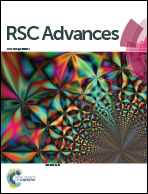Reducing Li-diffusion pathways via “adherence” of ultra-small nanocrystals of LiFePO4 on few-layer nanoporous holey-graphene sheets for achieving high rate capability†
Abstract
Olivine structured lithium iron phosphate, LiFePO4 (LFP), is a promising alternative cathode material due to its high theoretical capacity (170 mA h g−1), low cost and higher environmental compatibility. However, due to its poor electronic conductivity and Li+-ion diffusivity the electrochemical performance of LFP deteriorates with increasing charge/discharge rates. Networking of downsized LFP particles with an improperly chosen carbon conduit may not effectively reduce the Li+-ion diffusion pathways and improve electron transport. We demonstrate here a unique 3D configuration comprising ultra-small LFP particles (size: 5 ± 2 nm) “adhered” to few-layer reduced holey-graphene oxide sheets (h-GO) that allows Li+-ions to traverse shorter non-tortuous pathways. The h-GO sheets, which are only ≤1% of the total weight of the LFP-carbon assembly, contain micro (≈1.1–1.9 nm) to meso (≈2.8–13.9 nm) scale sized chemically punctured holes and hence the probability of their blockage by the ultra-small LFP nanocrystals is negligible. On the other hand, a higher content of sp2-carbon in h-GO compared to graphene oxide (GO) simultaneously provides excellent electronic conductivity. The assembly of adhered monodispersed LFP nanocrystals on h-GO sheets displayed theoretical capacity (over nearly 1000 cycles) and extremely high rate performance at widely varying current densities (0.1–10C). Choice of h-GO leads to an increase in the lithium diffusion, DLi+ in the LFP-h-GO by nearly two orders compared to the composite of LFP with non-porous graphene oxide (GO). The novel electrode architecture discussed here, which specifically exploits tweaking the charge transport pathways at small length scales (∼nm), will also be highly applicable for electrodes of relevance to various battery chemistries and supercapacitors.



 Please wait while we load your content...
Please wait while we load your content...